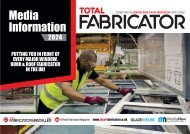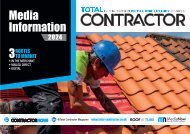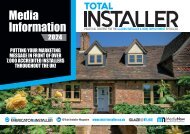September 2022
Create successful ePaper yourself
Turn your PDF publications into a flip-book with our unique Google optimized e-Paper software.
around the edges.<br />
A reputable rooflight supplier would be able to<br />
provide these accurate values for their product.<br />
Security<br />
Part Q Building Regulations state that ‘Ground<br />
floor, basement and other easily accessible<br />
windows (including easily accessible rooflights)<br />
should be secure windows made to a design that<br />
meets the security standards of British standards<br />
publication PAS 24:2012.’<br />
those below the rooflight.<br />
The term ‘toughened’ implies a degree of safety which<br />
in the case of rooflights, is misleading. Toughened<br />
glass inner panes actually bring a risk of shattering<br />
and falling into the room beneath. Therefore it’s<br />
difficult to see how use of a toughened rather than<br />
laminated glass inner pane doesn’t present a risk<br />
to anyone beneath a rooflight, whatever the position<br />
or height of the installation. For this reason, NARM<br />
asserts that any risk assessment of a toughened inner<br />
pane is largely irrelevant.<br />
For the safety of people needing to access roof areas,<br />
non-fragility classification should also be confirmed.<br />
The Centre for Window and Cladding Technology<br />
(CWCT) has devised specific non-fragility tests for<br />
large area glazing. These are referenced in the latest<br />
issue of ACR’s (Advisory Committee for Roofsafety)<br />
Red Book and NARM has published a document<br />
entitled Understanding CWCT Classifications of<br />
Rooflight Types. This can be downloaded free of<br />
charge at: www.narm.org.uk/new/wp-content/<br />
uploads/2021/08/NARM-Quickguide-8-CWCT-<br />
Classifications-1.jpg.<br />
Another important point to be aware of, is the very<br />
great difference between a rooflight classified as ‘nonfragile’,<br />
which is designed to provide a level of safety<br />
in the event of an accidental fall onto the rooflight;<br />
and a ‘walk-on’ rooflight, designed to allow frequent<br />
foot traffic for a roof terrace, for example. Walk-on<br />
roofllights are designed and built to floor loadings, to<br />
match the surrounding roof area – and are therefore<br />
much heavier and significantly more expensive<br />
than conventional rooflights. For more information,<br />
download our publication: Understanding the<br />
differences between non-fragile rooflights and walk-on<br />
rooflights: www.narm.org.uk/new/wp-content/<br />
uploads/2021/06/NTD11-2017.pdf<br />
Thermal performance<br />
Approved Document L of the Building Regulations<br />
defines the requirements for Conservation of Fuel and<br />
Power by setting the standards for energy performance<br />
and carbon emissions for new and existing buildings.<br />
This part of the Regulations has recently been<br />
updated. In respect of rooflights generally, the limiting<br />
rooflight U-value is now 2.2 W/(m 2 K) when assessed<br />
in the horizontal plane. It’s important to note that the<br />
quoted U-value needs to be for the whole rooflight, not<br />
just glass centre pane U-values, which we still see<br />
quoted by some suppliers.<br />
A cutaway of a rooflight, which should<br />
always be installed by a qualified person<br />
“Even a fully compliant, high quality rooflight can<br />
be compromised by inappropriate installation<br />
methods or standards on site”<br />
Even when just a DGU has been bonded to a timber<br />
upstand, the centre pane U-value is not the U-value<br />
for the installed rooflight as account has to be taken<br />
of the spacer bars and edge seal of the sealed unit,<br />
the centre pane U-value excludes these heat losses<br />
A PAS24 certification is a security standard that can<br />
only be met once a product has been certified for<br />
its security performance. The acceptable security<br />
standard ensures that products meet high-security<br />
performance levels, offering reassurance to<br />
homeowners that the entry points to their homes have<br />
been rigorously tested and are resistant to break-ins<br />
and home invasion.<br />
Products satisfying other standards that provide<br />
similar or better performance are also acceptable.<br />
These standards include: STS 204 Issue<br />
3:2012; LPS 1175 Issue 7:2010 security rating<br />
1; and LPS 2081 Issue 1:2015 security rating<br />
A. Frames should be mechanically fixed to the<br />
structure of the building in accordance with the<br />
manufacturer’s installation instructions.<br />
Other considerations<br />
Even a fully compliant, high quality rooflight can be<br />
compromised by inappropriate installation methods or<br />
standards on site. For this reason, we strongly advise<br />
close adherence to manufacturers’ installation guides<br />
and reference to any specific requirements relating to<br />
roof finishes abutting the rooflight.<br />
A simple way to ensure that the rooflights you<br />
specify for a project will meet appropriate standards<br />
and regulations, is to source them from a NARM<br />
member company. Our membership comprises<br />
businesses supplying all types of rooflights and<br />
NARM membership is only open to businesses whose<br />
products are fully compliant.<br />
Contact NARM:<br />
0161 224 7477<br />
www.narm.org.uk<br />
@_NARMUK<br />
PRACTICAL CONTENT FOR THE GLAZING INSTALLER & HOME IMPROVEMENT SPECIALIST<br />
SEPTEMBER <strong>2022</strong> TI 67

















